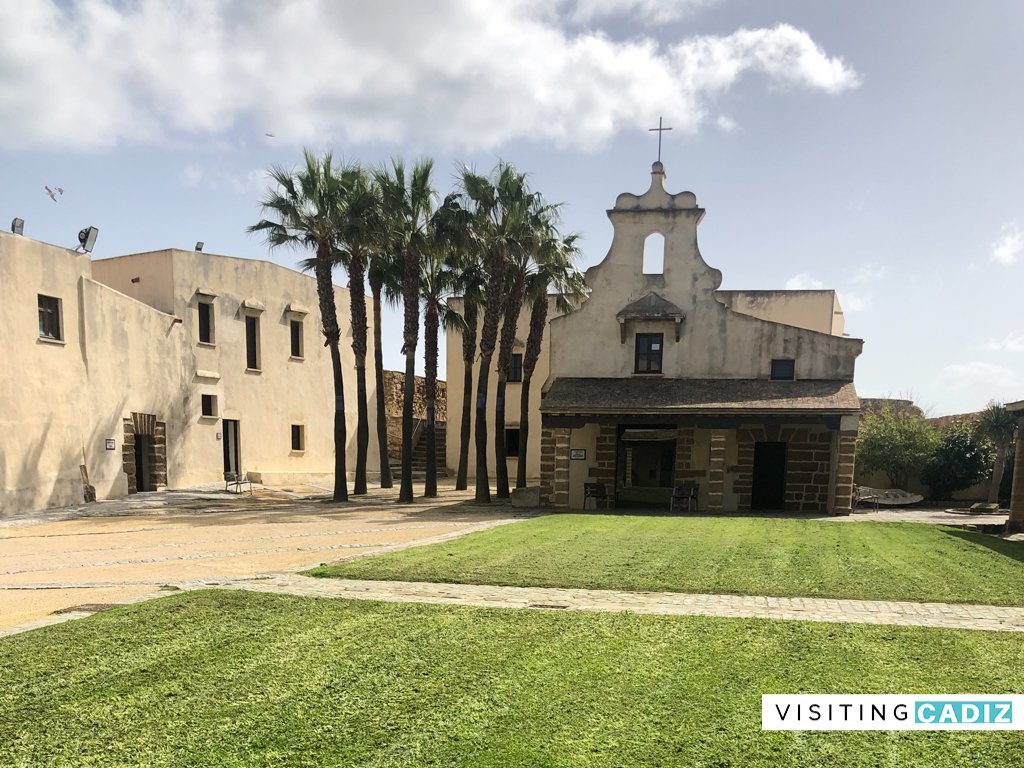After the Anglo-Dutch sack of the city in 1596, King Felipe II sent the engineer Cristóbal de Rojas to Cádiz to carry out a defense project. Rojas considered that the quickest and most effective way to protect the city was to design a fortification in the bay of Santa Catalina. So, in order to defend the most vulnerable maritime borders of the city of Cádiz, the fortress of Santa Catalina was built.

The building represents an important example of modern military architecture and has survived to this day without any major changes or warfare damage. It has a star-shaped plan with two well defined fronts. One is formed by triangular bastions that rest on the beach and the other open towards the city where the only gate to the enclosure is located. This is protected by two bastions and a moat/ditch which used to regulate the level of water through various locks. Access is across a bridge to a simple door protected by an upper guardhouse. Here there is a plaque that commemorates the completion of the works during the reign of Felipe II.
The Cádiz Audio Guided Tour

The fortress of Santa Catalina is included in the Visit Cádiz audio guided tour. Check it out here: https://visitingcadiz.com/immerse-yourself-in-cadizs-rich-history-a-guided-audio-tour/
Or, just scan the QR code on the left with your mobile phone.
Search for guided tours and activities in Cádiz here: https://visitingcadiz.com/guided-tours-and-activities-in-cadiz/

The fortress has been transformed into a large multipurpose cultural and leisure space which includes temporary exhibition halls, educational workshops for students. Artistic, craft workshops and concerts are also organized in the Plaza de las Armas del Castillo along with outdoor activities during the summer.

Ask in the tourist office or your hotel for information about any upcoming events here.
Opening Times
- Every day from 11:00 a.m. to 8:30 p.m.
Fortress of Santa Catalina, Cádiz – History, Architecture and Visitor Guide
The Fortress of Santa Catalina is one of Cádiz’s most notable examples of modern military architecture. Built after the Anglo-Dutch attack of 1596 under King Felipe II’s orders, it was designed by engineer Cristóbal de Rojas to protect the city’s coastline. Its star-shaped design reflects late 16th-century military innovation, much of which still stands today. You can explore more of its fascinating story in our full guide.
Cristóbal de Rojas, a prominent Spanish military engineer, designed the fortress to defend Cádiz’s most vulnerable maritime borders. Commissioned by King Felipe II, construction began after the devastating sack of 1596. The fort became a vital part of Cádiz’s coastal defence system — and remarkably, it remains largely intact centuries later.
The fortress is known for its distinctive star-shaped layout and dual fronts. One side faces the beach with triangular bastions, while the city-facing side features a single guarded gate, moat, and drawbridge. Inside, pavilions surround a central courtyard, and the 1693 chapel of Santa Catalina adds an elegant touch. Our article explores these features in greater detail.
Yes, the fortress is open daily from 11:00 a.m. to 8:30 p.m. It has been transformed into a vibrant cultural venue hosting exhibitions, workshops, and concerts in the Plaza de las Armas. Visitors can stroll through the old ramparts, explore the chapel, and enjoy seaside views. For the latest events, it’s worth checking with the local tourist office or your hotel.
Today, the fortress serves as a lively cultural space. It hosts art and craft exhibitions, music concerts, educational workshops for students, and outdoor summer activities. The atmosphere blends history with creativity, offering a glimpse of Cádiz’s modern cultural life. Specific schedules vary, so locals and tourists alike often check for updates before visiting.
You can discover the fortress and its surroundings with Clive’s Cádiz Audio Walking Tour, available via VoiceMap. The tour offers immersive storytelling as you explore landmarks across Cádiz, including Santa Catalina.
I’ve been living in this lovely area of Western Andalucia for the last 20 years or so and dedicate most of my time to the running of English language tourist information websites for the towns of Cádiz, Ronda, Grazalema, the famous or infamous Caminito del Rey, and also Wildside Holidays, which promotes sustainable and eco-friendly businesses running wildlife and walking holidays in Spain. My articles contain affiliate links that will help you reserve a hotel, bus, train or activity in the area. You don’t pay more, but by using them you do support this website. Thankyou!